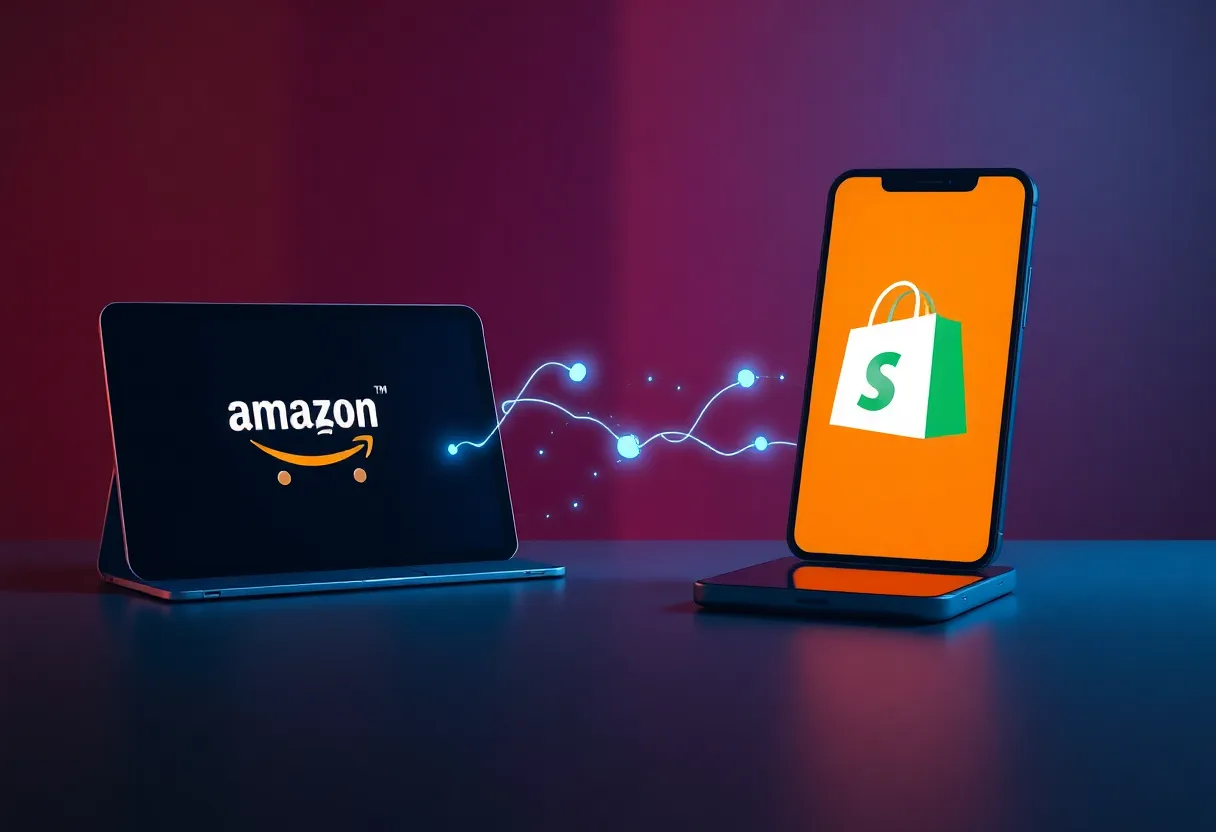Table of Contents
The E-commerce Integration Landscape
Did you know that 87% of shoppers now start their product searches on digital channels? This shift has pushed more businesses to sell across multiple platforms. But managing several storefronts can quickly become a juggling act.
Online sellers face a growing need to be everywhere their customers are. This means having a presence on major marketplaces like Amazon, as well as running their own Shopify stores. However, keeping track of inventory, orders, and customer data across different platforms often leads to headaches.
Here’s a quick look at why multi-channel selling matters:
- Wider reach to potential customers
- Increased brand visibility
- Diversified revenue streams
- Better risk management
But with these benefits come some tricky challenges:
- Keeping inventory in sync
- Managing orders from different sources
- Maintaining consistent pricing
- Tracking performance across platforms
This is where integration tools step in to save the day. They act like a bridge between your Shopify store and other sales channels, making sure everything stays in harmony.
Let’s take a look at how sellers typically manage multiple channels:
| Method | Time Spent Daily | Error Rate |
|---|---|---|
| Manual Updates | 3-4 hours | 5-10% |
| Basic Automation | 1-2 hours | 2-5% |
| Advanced Integration | 15-30 minutes | <1% |
As you can see, using the right tools can drastically cut down on time and mistakes. This is crucial for growing your business without growing your workload.
For a deeper dive into connecting Amazon and Shopify, check out this helpful video:
As more businesses catch on to the power of multi-channel selling, the need for smooth integration becomes clear. Tools like Marketplace Connect are stepping up to meet this need, helping sellers manage their expanded online presence without the usual hassles.
Step-by-Step Amazon-Shopify Connection Guide
Connecting your Amazon store to Shopify can open up new opportunities for your e-commerce business. Let’s walk through the process to get you started.
First things first, you’ll need an active Amazon seller account. If you don’t have one yet, head over to Amazon Seller Central and sign up. Once that’s sorted, it’s time to choose the right integration tool.
- Research integration apps – Look for ones that offer features like inventory syncing and order management
- Read reviews – Check what other sellers say about ease of use and customer support
- Compare pricing – Find an option that fits your budget and offers good value
One solid choice is Marketplace Connect, which starts at $19.99 per month and comes with a free trial. It’s designed specifically for seamless Shopify integration and supports multiple marketplaces.
Once you’ve picked your integration app, it’s time to set things up. Here’s a quick rundown:
- Install the app on your Shopify store
- Connect your Amazon account
- Map your product categories
- Configure inventory and pricing sync settings
- Set up order fulfillment preferences
Remember, the goal is to create a smooth flow between your Shopify store and Amazon listings. This way, when a customer buys from either platform, your inventory updates automatically across both.
This video offers a detailed walkthrough of connecting Shopify with Amazon, which can be super helpful if you’re more of a visual learner.
Optimizing Your Multi-Channel Strategy
Now that you’re set up on both platforms, it’s time to fine-tune your approach. Managing products and orders across Amazon and Shopify requires some strategy.
Unified Inventory Management
Keeping track of stock across multiple channels can be tricky. Here are some tips to stay on top of things:
- Use a central inventory management system
- Set buffer stock levels to avoid overselling
- Regularly audit your inventory to catch discrepancies
With tools like Marketplace Connect, you can automate a lot of this process. It updates inventory in real-time, so you’re less likely to run into stock issues.
Pricing Strategies
Different channels might require different pricing. Consider these factors:
- Platform fees and commissions
- Shipping costs
- Competitor pricing on each platform
- Customer expectations
You might find that you need to adjust your prices on Amazon to account for their fees, while keeping Shopify prices lower to encourage direct purchases.
Streamlining Order Fulfillment
Efficient order processing is key to customer satisfaction. Here’s how to keep things running smoothly:
- Centralize order management
- Standardize packaging and shipping processes
- Use automation tools to reduce manual data entry
By using an integration tool, you can manage orders from both Amazon and Shopify in one place. This cuts down on time and reduces the chance of errors.
Leveraging Data for Growth
One of the biggest advantages of connecting Amazon to Shopify is the wealth of data you’ll have at your fingertips. Let’s look at how to use this info to boost your sales.
Analyzing Cross-Platform Performance
Comparing how products perform on each platform can offer valuable insights. Here’s a simple comparison table:
| Metric | Amazon | Shopify |
|---|---|---|
| Average Order Value | $45 | $60 |
| Conversion Rate | 3.2% | 2.8% |
| Return Rate | 5% | 3% |
This kind of data can help you decide where to focus your efforts. For example, you might want to work on increasing your Shopify conversion rate to match Amazon’s.
Customer Insights
By selling on multiple channels, you can gather more diverse customer data. Use this to:
- Identify your most valuable customer segments
- Tailor your marketing messages for each platform
- Spot trends in customer behavior and preferences
Tools like Marketplace Connect can help aggregate this data, making it easier to spot patterns and make informed decisions.
Adapting Strategies
The e-commerce landscape is always changing. Stay flexible and be ready to adjust your approach based on what the data tells you. This might mean:
- Shifting inventory between platforms
- Adjusting your product mix
- Changing your pricing strategy
- Tweaking your marketing efforts
Remember, the goal is to use the strengths of both Amazon and Shopify to grow your business. By keeping a close eye on your data and being willing to adapt, you can make the most of this powerful combination.
Impact of Amazon-Shopify Integration on Business
Connecting your Amazon store to Shopify can be a game-changer for e-commerce businesses. Let’s break down the key impacts:
Increased Sales Potential
By integrating Amazon with Shopify, sellers tap into a massive customer base. Here’s why this matters:
- Wider reach: Amazon’s 300+ million active users become potential customers
- Trust factor: Leverage Amazon’s established brand reputation
- Diversified revenue: Reduce dependence on a single sales channel
However, success isn’t guaranteed. Sellers need to navigate Amazon’s competitive landscape and pricing strategies carefully.
Operational Efficiency Gains
Integration streamlines operations in several ways:
- Centralized inventory management
- Automated order processing
- Synchronized product information
These efficiencies free up time for strategic tasks like marketing and product development. Tools like Marketplace Connect can further simplify multi-channel management.
Potential Pitfalls and Solutions
While integration offers benefits, there are challenges to consider:
| Pitfall | Solution |
|---|---|
| Inventory discrepancies | Use real-time sync tools |
| Pricing conflicts | Implement dynamic pricing strategies |
| Customer service complexity | Adopt unified customer management systems |
Addressing these challenges head-on ensures a smoother integration process. Remember, the goal is to enhance your business operations, not complicate them.
By thoughtfully connecting Amazon to Shopify, sellers can boost sales while streamlining their workflow. It’s about finding the right balance and using the proper tools to support your growth.
Wrap-up
Connecting your Amazon store to Shopify can open up new opportunities for your e-commerce business. By syncing inventory, orders, and tracking across platforms, you’ll save time and reduce errors. This lets you focus on growing your business instead of juggling multiple systems.
To get started, look into integration tools that fit your needs and budget. Our Marketplace Connect app offers features like real-time inventory updates and unified order management to streamline your multi-channel selling.
As online shopping continues to evolve, having a smooth connection between your sales channels will be key. Take some time to explore your options and find a solution that works for you. With the right setup, you’ll be well-positioned to boost your sales and reach more customers across different marketplaces.
Still have questions about connecting Amazon to Shopify? Check out our FAQ section below for more info.
Common Questions About Amazon-Shopify Integration
How much does it cost to connect Amazon to Shopify?
The cost varies depending on the integration method you choose. Some apps, like Marketplace Connect, offer plans starting at $19.99 per month with a free trial. Native integrations may have different pricing structures. It’s best to compare options to find the most cost-effective solution for your business needs.
How long does it take to set up an Amazon-Shopify connection?
The setup time can range from a few hours to a couple of days, depending on your technical skills and the complexity of your product catalog. Using a dedicated integration app can significantly speed up the process. Most sellers can get connected within a day using user-friendly tools designed for this purpose.
How do I handle product variations across Amazon and Shopify?
Many integration tools automatically map product variations between platforms. You’ll need to ensure your product data is consistent and follows the requirements of both Amazon and Shopify. Some apps offer features to help manage and sync variations, making it easier to keep your listings uniform across channels.
Can I manage customer service for both platforms in one place?
Yes, several integration solutions offer unified order management features. This allows you to handle customer inquiries, process returns, and manage communications from a single dashboard. It streamlines your workflow and helps maintain consistent customer service across all sales channels.
Will connecting Amazon to Shopify affect my existing listings?
When done correctly, connecting Amazon to Shopify shouldn’t negatively impact your existing listings. Most integration tools are designed to sync data without overwriting your current setups. However, it’s always a good practice to back up your product data before making any significant changes to your e-commerce setup.
How does inventory syncing work between Amazon and Shopify?
Inventory syncing is typically handled in real-time by integration apps. When a sale occurs on either platform, the inventory is automatically updated across both channels. This prevents overselling and keeps your stock levels accurate. Tools like Marketplace Connect offer dynamic inventory updates to ensure you’re always showing the correct availability to customers.





